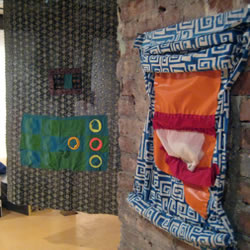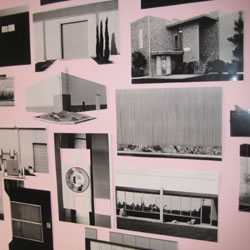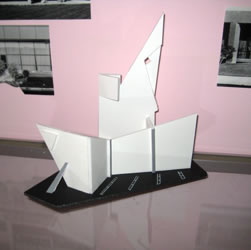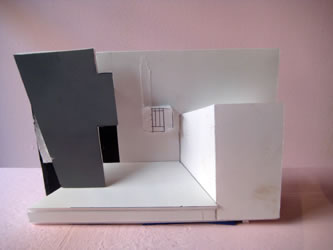


Main Space
Calais Guild Prayer Blankets (September 13 - December 12, 2009)
Prayer blankets made of old sweaters, plastic bags, packing blankets, curtain fabric, and other odds and ends. These blankets were commissioned by Triple Candie and are based on photos of blankets originating in a community guild in southeastern Maine.
From the Wall Text:
The town of Calais lies on the banks of the St. Croix River -- a narrow expanse separating eastern Maine from Canada. It is one of those places seemingly lost to time. For the past one hundred fifty years, Calais' residents have remained overwhelmingly Caucasian (97%) but its population has been slowly declining. Today it clocks in at just under 3,500 residents. In demographic terms, the town is wilting.
Food poisoning was the reason we ended up in Calais in the summer of 2004. On a drive from New York to Nova Scotia, we stayed for two days so Shelly could upchuck and sleep. Peter staved off boredom by reading and taking long walks around the town. It was during one of these walks that he stumbled upon an old church with its doors open and a group of women sewing inside.
The quilt-like objects hanging before you are recreations of blankets made by these women, all members of the Calais Guild. Originally founded in the 1880s as the Calas Women's Guild, the group meets several times a week to discuss local and domestic issues -- family, spirituality, sexuality, sickness -- and to make things from the old, often stained or torn clothing and scaps of fabric that the woman brings to the meetings. (It is considered gauche to bring something new: it is essential that the materials have a history, a story already in the making.) The two activities -- talking and ewing -- generally happen simultaneously and the resulting objects are called "prayer blankets." Sometimes the women exchange the blankets among themselves, but more often than not they gift them to people going through crises or symbolic life-transitions. For both the giver and the recipient, the purpose in having one of these blankets is to benefit from its energy.
All of the blankets on view here were reconstructed from photographs Peter took on that memorable trip. Guild members will not allow their creations to be sold, exhibited, or lent, but flattered by Peter's curiosity and enthusiasm (and attracted to his Keith-Partridge-looks) several let him take snapshots. He took the photos quickly, asked a few questions, and then left.
By craft -- even artistic -- standards there prayer blankets are not very good. They show little technical virtuosity and the compositions are simplistic and haphazard. They also seem to lack any deep understanding of the medium's history. The crude use of throwaway materials -- with the same types showing up repeatedly across multiple examples -- lends the works a type of homeyness, but also a kind of hokeyness. But all in all, they evoke a freshness and lack of self-consciousness that is rare in contemporary art today.
Lewis Baltz's Picturesque (November 22, 2009 - January 17, 2010)
In the 1970s, Lewis Baltz (b. 1945, Newport Beach, California) realized several photographic series that documented tract house developments and industrial parks in California and Utah. The works were remarkable at the time for being so unremarkable: the compositions are geometric, the images flat, and the lifeless subjects are treated with a matter-of-factness that echoes the concerns of both Minimalism and Conceptual Art.
Baltz insists that these series be exhibited intact and in predetermmined sequences. The New Industrial Parks near Irvine, California (1974), shown here, was first exhibited at Leo Castell Gallery in 1975. It was hung in a grid and accompanied by a limited-edition book of the same title.
"The mission of photography was to deliver the world and all its contents into the category of the picturesque. None of which has anything to do with art. -- Lewis Baltz



